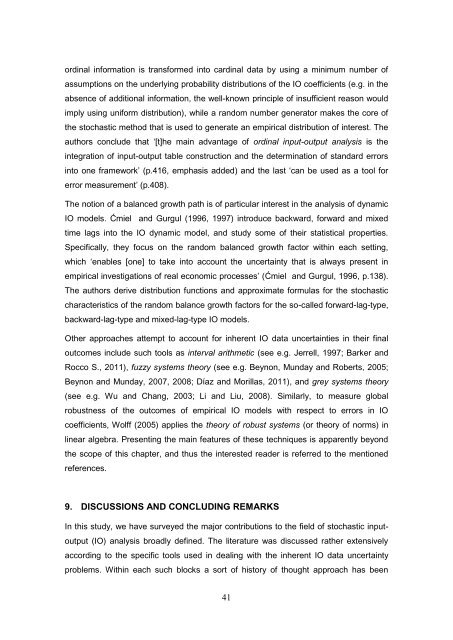Uncertainty treatment in input-output analysis
ifDakU
ifDakU
Create successful ePaper yourself
Turn your PDF publications into a flip-book with our unique Google optimized e-Paper software.
ord<strong>in</strong>al <strong>in</strong>formation is transformed <strong>in</strong>to card<strong>in</strong>al data by us<strong>in</strong>g a m<strong>in</strong>imum number of<br />
assumptions on the underly<strong>in</strong>g probability distributions of the IO coefficients (e.g. <strong>in</strong> the<br />
absence of additional <strong>in</strong>formation, the well-known pr<strong>in</strong>ciple of <strong>in</strong>sufficient reason would<br />
imply us<strong>in</strong>g uniform distribution), while a random number generator makes the core of<br />
the stochastic method that is used to generate an empirical distribution of <strong>in</strong>terest. The<br />
authors conclude that „[t]he ma<strong>in</strong> advantage of ord<strong>in</strong>al <strong>in</strong>put-<strong>output</strong> <strong>analysis</strong> is the<br />
<strong>in</strong>tegration of <strong>in</strong>put-<strong>output</strong> table construction and the determ<strong>in</strong>ation of standard errors<br />
<strong>in</strong>to one framework‟ (p.416, emphasis added) and the last „can be used as a tool for<br />
error measurement‟ (p.408).<br />
The notion of a balanced growth path is of particular <strong>in</strong>terest <strong>in</strong> the <strong>analysis</strong> of dynamic<br />
IO models. Ćmiel and Gurgul (1996, 1997) <strong>in</strong>troduce backward, forward and mixed<br />
time lags <strong>in</strong>to the IO dynamic model, and study some of their statistical properties.<br />
Specifically, they focus on the random balanced growth factor with<strong>in</strong> each sett<strong>in</strong>g,<br />
which „enables [one] to take <strong>in</strong>to account the uncerta<strong>in</strong>ty that is always present <strong>in</strong><br />
empirical <strong>in</strong>vestigations of real economic processes‟ (Ćmiel and Gurgul, 1996, p.138).<br />
The authors derive distribution functions and approximate formulas for the stochastic<br />
characteristics of the random balance growth factors for the so-called forward-lag-type,<br />
backward-lag-type and mixed-lag-type IO models.<br />
Other approaches attempt to account for <strong>in</strong>herent IO data uncerta<strong>in</strong>ties <strong>in</strong> their f<strong>in</strong>al<br />
outcomes <strong>in</strong>clude such tools as <strong>in</strong>terval arithmetic (see e.g. Jerrell, 1997; Barker and<br />
Rocco S., 2011), fuzzy systems theory (see e.g. Beynon, Munday and Roberts, 2005;<br />
Beynon and Munday, 2007, 2008; Díaz and Morillas, 2011), and grey systems theory<br />
(see e.g. Wu and Chang, 2003; Li and Liu, 2008). Similarly, to measure global<br />
robustness of the outcomes of empirical IO models with respect to errors <strong>in</strong> IO<br />
coefficients, Wolff (2005) applies the theory of robust systems (or theory of norms) <strong>in</strong><br />
l<strong>in</strong>ear algebra. Present<strong>in</strong>g the ma<strong>in</strong> features of these techniques is apparently beyond<br />
the scope of this chapter, and thus the <strong>in</strong>terested reader is referred to the mentioned<br />
references.<br />
9. DISCUSSIONS AND CONCLUDING REMARKS<br />
In this study, we have surveyed the major contributions to the field of stochastic <strong>in</strong>put<strong>output</strong><br />
(IO) <strong>analysis</strong> broadly def<strong>in</strong>ed. The literature was discussed rather extensively<br />
accord<strong>in</strong>g to the specific tools used <strong>in</strong> deal<strong>in</strong>g with the <strong>in</strong>herent IO data uncerta<strong>in</strong>ty<br />
problems. With<strong>in</strong> each such blocks a sort of history of thought approach has been<br />
41


